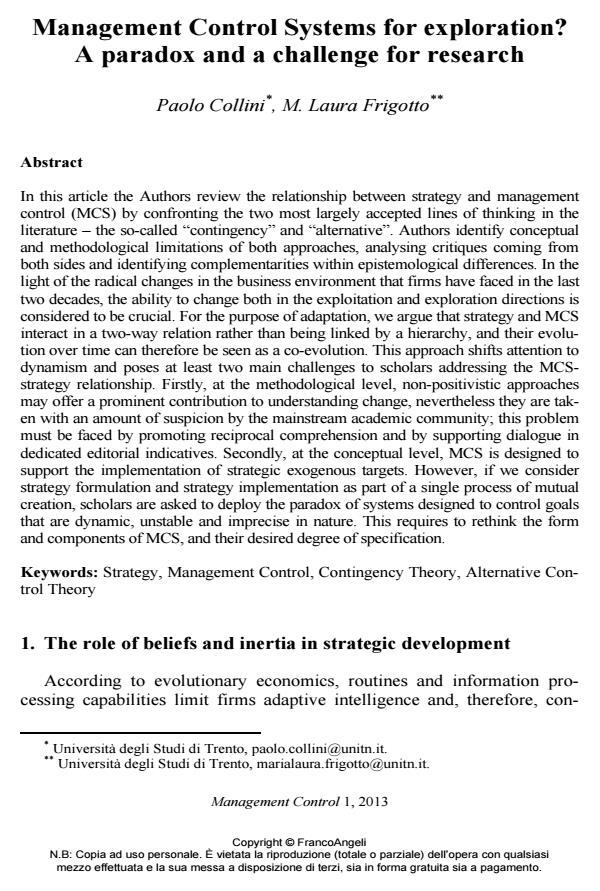Management Control Systems for exploration? A paradox and a challenge for research
Journal title MANAGEMENT CONTROL
Author/s Paolo Collini, Maria Laura Frigotto
Publishing Year 2013 Issue 2013/1
Language Italian Pages 18 P. 27-44 File size 665 KB
DOI 10.3280/MACO2013-001003
DOI is like a bar code for intellectual property: to have more infomation
click here
Below, you can see the article first page
If you want to buy this article in PDF format, you can do it, following the instructions to buy download credits

FrancoAngeli is member of Publishers International Linking Association, Inc (PILA), a not-for-profit association which run the CrossRef service enabling links to and from online scholarly content.
In this article the Authors review the relationship between strategy and management control (MCS) by confronting the two most largely accepted lines of thinking in the literature - the so-called "contingency" and "alternative". Authors identify conceptual and methodological limitations of both approaches, analysing critiques coming from both sides and identifying complementarities within epistemological differences. In the light of the radical changes in the business environment that firms have faced in the last two decades, the ability to change both in the exploitation and exploration directions is considered to be crucial. For the purpose of adaptation, we argue that strategy and MCS interact in a two-way relation rather than being linked by a hierarchy, and their evolution over time can therefore be seen as a co-evolution. This approach shifts attention to dynamism and poses at least two main challenges to scholars addressing the MCSstrategy relationship. Firstly, at the methodological level, non-positivistic approaches may offer a prominent contribution to understanding change, nevertheless they are taken with an amount of suspicion by the mainstream academic community; this problem must be faced by promoting reciprocal comprehension and by supporting dialogue in dedicated editorial indicatives. Secondly, at the conceptual level, MCS is designed to support the implementation of strategic exogenous targets. However, if we consider strategy formulation and strategy implementation as part of a single process of mutual creation, scholars are asked to deploy the paradox of systems designed to control goals that are dynamic, unstable and imprecise in nature. This requires to rethink the form and components of MCS, and their desired degree of specification.
Keywords: Strategy, Management Control, Contingency Theory, Alternative Control Theory
- A field study of Value-Based Management sophistication: The role of shareholders Andrea Dello Sbarba, Riccardo Giannetti, Alessandro Marelli, in MANAGEMENT CONTROL 2/2015 pp.65
DOI: 10.3280/MACO2015-002004 - Management Control System in Smart and Sustainable Firms Domenica Lavorato, pp.59 (ISBN:978-3-031-81435-8)
- Inter-firm coordination as an Information problem. The case of a divisionalized company Antonio Leotta, in MANAGEMENT CONTROL 2/2016 pp.167
DOI: 10.3280/MACO2016-002008 - Accrual accounting and performance measurement: Empirical evidences from two Italian municipalities Eleonora Cardillo, Carmela Rizza, in MANAGEMENT CONTROL 2/2015 pp.135
DOI: 10.3280/MACO2015-002006
Paolo Collini, Maria Laura Frigotto, Management Control Systems for exploration? A paradox and a challenge for research in "MANAGEMENT CONTROL" 1/2013, pp 27-44, DOI: 10.3280/MACO2013-001003